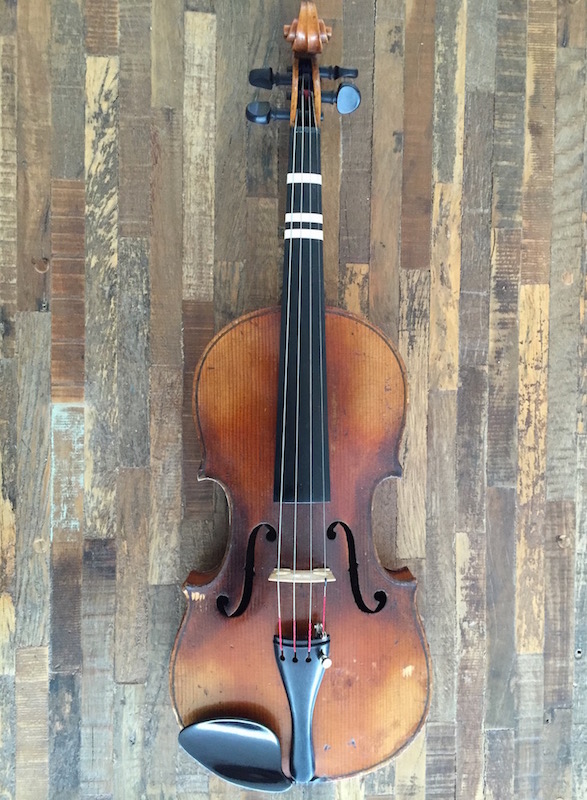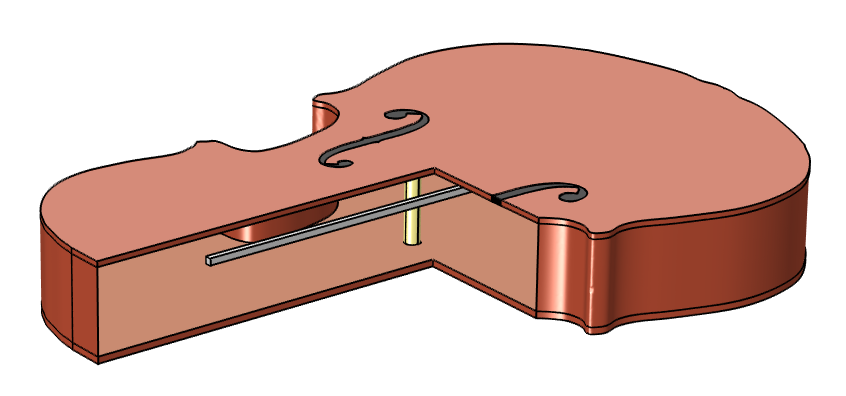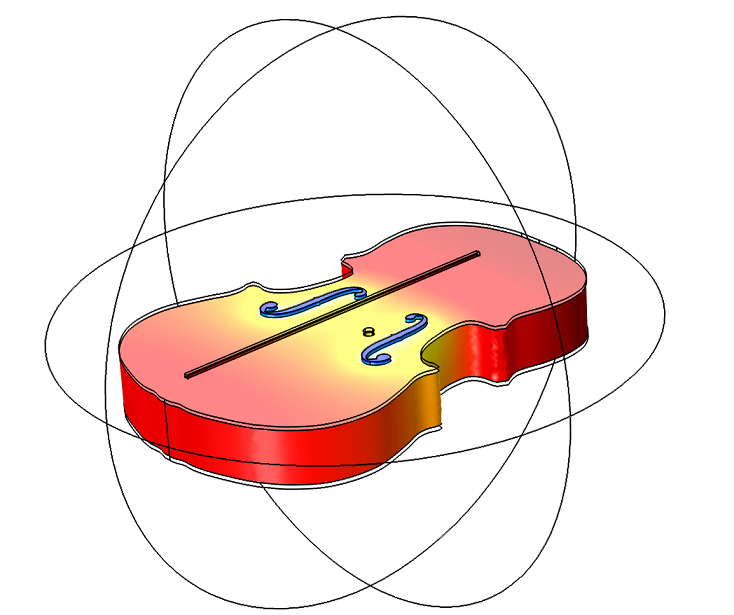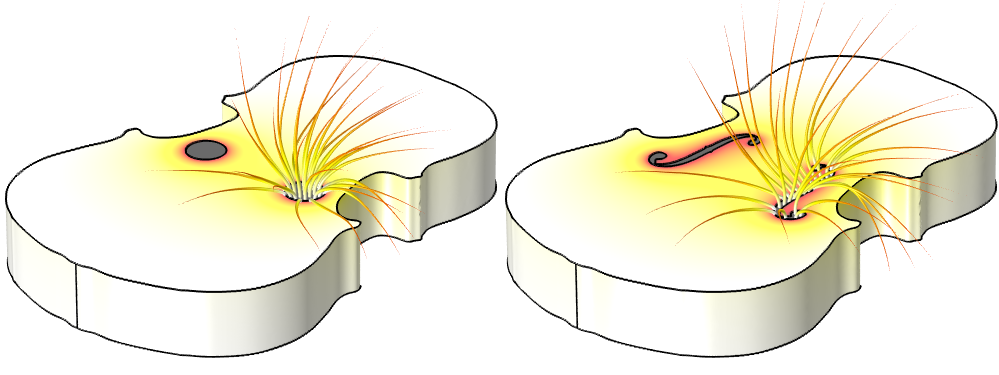
Over the 10th through 18th centuries, the sound holes in violins evolved from a circular shape to an elongated f shape. In a recent research paper, MIT scientists and violin makers from the North Bennet Street School in Boston investigated the effects of this change in shape. They suggest that the f-shaped holes increase the airflow, making the bass notes of the violin twice as loud. Today, we will reproduce their findings with COMSOL Multiphysics.
The Physics Behind Violins
The science of violins is as complex and diverse as the music they create. You can find published research on anything from bowing biomechanics to a study on whether elite violinists can distinguish an original Stradivarius from a present-day instrument while blindfolded (spoiler: they can’t).

A violin.
Like the MIT researchers, our study will focus on the fundamental air mode resonance around 280 to 300 Hz. At higher frequencies, the sound that a violin creates is primarily reinforced by its vibrating body, but at this frequency, the air inside the violin resonates. Consequently, much of the sound from the low notes radiates out through the f-holes.
As a first approximation, the air mode is often seen as a Helmholtz resonance, taking place purely in the air. As part of their experiment, the research team made simulations and measurements to find out how vibrations in a violin body affect the resonance frequency. In case you are wondering what experimental conditions are required for suppressing body vibrations, don’t worry — there’s no need to make a violin out of concrete. The team simply clamped a regular violin in some strategic positions, hindering virtually all vibrations.
Of course, in a COMSOL Multiphysics model, this type of experiment is even easier. If you set up an acoustic-structure interaction model, the resonance will automatically couple to the solid. Then, by disabling the structure, you are left with only the air vibrating. For this model, I didn’t have access to a CAD file of a violin, so I created an original geometry that is reasonably realistic, while not overly complicated. After researching the anatomy of a violin online, I decided to set up the geometry as shown below.

Violin model geometry, consisting of flat top and bottom plates, rigid sides, f-holes (black), a reinforcing bass bar (gray) fixed underneath the top plate, and a sound post (yellow) connecting the plates.
I didn’t try to recreate any particular brand of violin, but sketched the body and f-holes freehand and scaled them to the standard measurements for a full-sized violin. As the sides of the violin body are typically quite rigid and are not expected to actively affect the resonance, I made them sound hard boundaries. For the rest of the body, I used a spruce material with a Young’s modulus of 10 GPa.
Setting the Tone: Simulating Acoustic-Structure Interaction
The figure below shows the pressure acoustics solution, for which we treat the entire body as sound hard. The color scale represents the sound pressure level on the inside of the violin and in the f-holes. We include the outlined air half-sphere outside of the violin in order to let the mode freely decay rather than be artificially cut off just above the holes. The eigenfrequency we get from this analysis is 304 Hz.

The sound pressure level distribution in the pressure acoustics solution of the air mode resonance, found at 304 Hz. The scale ranges from blue (low) to red (high). The sound pressure level is computed everywhere, but not shown in the outside air.
With the structure included, we add flexibility to the system and expect the eigenfrequency to decrease. This is precisely what happens in the model. While the basic shape of the acoustic mode (not shown here) remains almost identical, the top and bottom plates now join in and act as springs and increase the compliance of the system. As you can see in the plots below, they both bend outwards to accommodate the pressure inside the cavity. This brings down the eigenfrequency to 287 Hz.

Three-quarter and side views of the violin body deformations at the phase of maximum pressure in the cavity. The eigenfrequency is now lowered to 287 Hz.
The 17 Hz (6%) eigenfrequency decrease from including the solid in the calculation is remarkably consistent with the researchers’ findings. From their experiments with a real violin, they report free and clamped eigenfrequencies that are both slightly higher than our results. Yet the 6% difference is the same, supporting their notion that this ratio is relatively insensitive to the specifics of the instrument. The conclusion is clear and you can hereby consider it confirmed: a 6% eigenfrequency decrease is a full semitone. If you want a well-tuned instrument, you need to take the acoustic-structure interaction into account!
Setting the Volume: Modeling Airflow
On to the main question brought up in this blog post: What is the effect of the hole shape? The research paper discusses both analytical and simulated results for various holes set in infinite sound hard surfaces. This idealization is certainly a good idea if we want to separate the effect of the hole shape from other design modifications over time. However, since we already have our violin geometry, we can use this information to find out what difference the shape of the hole makes on volume.
The researchers propose a rather simple model for the airflow: Solve a potential flow equation in the air outside the infinite hard surface (or in our case, the violin). For boundary conditions, set the potential to a constant value on the surface of the holes and to zero at infinity. When we integrate the resulting flux out of the holes, we have a relative measure of the airflow.
COMSOL Multiphysics has a Compressible Potential Flow interface, which solves a similar but slightly more advanced version of the equation in the paper. We’ll apply the zero potential condition to the surface of a large air sphere surrounding the violin. To get a fair comparison, we must make sure to give the round holes the exact same surface area as the f-holes.

The velocity potential distribution and airflow out of circular and f-shaped holes. The flow is only shown for one of the holes.
The ratio of flow between the different geometries is 1.51 in favor of the f-holes. If we take the sound power to be proportional to the flow squared, this gives a maximum ratio in the produced sound of 1.512 = 2.28. But that ratio is even greater than the reported factor, which is 2. Did the model results shoot over the target this time? Once again, the tacit assumption of no solid vibrations and no solid transmissions proves less than perfect. The research team estimates that the sound production of a real, flexible violin at the air mode resonance is closer to the calculated airflow raised to the power of 1.7. I would love to set up a model investigating this proposition. For now though, I am content to note that 1.511.7 = 2.01 ≈ 2.
Learn More About Modeling Musical Instruments in COMSOL Multiphysics
- Try it yourself: Download the Acoustic-Structure Interaction and Airflow in Violins tutorial model
- Read the discussed research paper: H.T. Nia et al. “The evolution of air resonance power efficiency in the violin and its ancestors,” The Royal Society, 2015.
- Read a blog post about the mathematical modeling of the skin of a drum



Comments (5)
Marty Kasprzyk
April 19, 2017Is the increase in sound output of a f hole compared to a round hole due to its long shape being closer to the internal high pressure areas in the upper and lower bouts or is it due to an easier air flow through the f holes? Or is it due to the increased flexibility of the shell due to the long f hole cuts?
I’m a retired mechanical engineer and as a new interest I’m developing new violin and viola designs and these studies are very helpful to me.
Linus Andersson
April 20, 2017 COMSOL EmployeeHi Marty,
The air flow simulations start out assuming that the violin body is perfectly rigid, and that the velocity potential is constant across the surface of the holes. Hence the raw result of a factor 2.28 increase in sound power is only due to the higher conductance provided by the f-holes . As I understand it, the measured factor of 2 being slightly less than that would rather suggest that the other effects you are citing favor round holes. It’s a complex situation though – I’d highly recommend reading the paper for more details.
Benoît Cuilhé
May 29, 2017Excuse me, I don’t understand the first boundary condition “set the potential to a constant value on the surface of the holes”. This implies that the air velocity on the surface of the holes is equal to 0 doesn’t it?
Linus Andersson
May 30, 2017 COMSOL EmployeeHi Benoît,
A constant velocity potential on a surface does not imply a zero velocity. Rather, it means that the velocity (which is the gradient of the potential) is perpendicular to the surface.
Robert Zuger
October 18, 2018Hi, making violins and viola I’m interested to know what structure the viobrational behavior is orientated to. I hold the sound post as center of rotation. What structure did you use in the program?